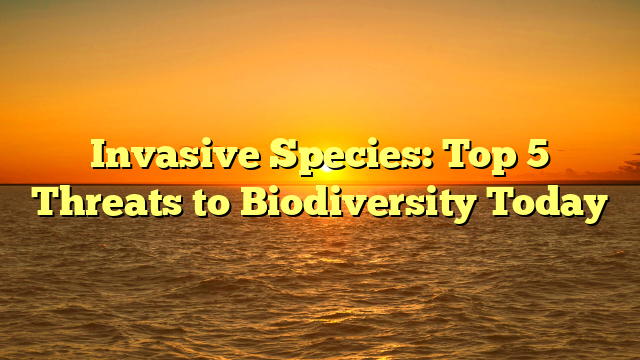Invasive Species
In a world the place ecosystems are more and more pressured by human actions, invasive species have emerged as one of the formidable threats to biodiversity. These non-native organisms can wreak havoc on native natural world, disrupt meals chains, and alter habitats. Regardless of their typically alluring appearances, these species are to not be underestimated. This text delves into the highest 5 invasive species that pose important threats to biodiversity at the moment, shedding gentle on why they’re harmful and the way we are able to fight their unfold.
Understanding Invasive Species

Earlier than diving into the precise threats, it’s important to understand what constitutes an invasive species. An invasive species is often outlined as a non-native organism that, when launched to a brand new atmosphere, establishes, spreads, and causes ecological or financial hurt. Invasive species may be vegetation, animals, or microorganisms, and so they typically out-compete native species for assets, resulting in declines in native populations.
Launched versus Invasive
It’s essential to distinguish between “launched” and “invasive.” Whereas all invasive species are launched, not all launched species turn into invasive. The transition from launched to invasive typically depends on a number of components, together with the species’ reproductive capabilities, absence of pure predators, and environmental adaptability.
The Prime 5 Invasive Species Threatening Biodiversity
1. Asian Carp
Origin: Asia
Launched: Nineteen Seventies to regulate algae and weed development in fish farms
The Asian carp contains a number of species, primarily the bighead and silver carp. Their introduction into U.S. waters has resulted in devastating impacts on native aquatic ecosystems. They eat massive quantities of plankton, which is the first meals supply for a lot of native fish species. Consequently, this results in a decline in native fish populations, disrupting the whole aquatic meals internet. The quickly reproducing Asian carp are tough to regulate, and so they have already infiltrated the Nice Lakes, threatening native fisheries and biodiversity.
2. Burmese Python
Origin: Southeast Asia
Launched: Nineteen Seventies as pets, now prevalent in Florida
The Burmese python has gained notoriety as a predator within the Florida Everglades, the place it has established a big inhabitants. This invasive snake preys on a variety of native wildlife, together with mammals and birds, resulting in marked declines in these populations. The absence of pure predators permits the Burmese python to thrive, posing a critical risk to the fragile stability of the Everglades ecosystem. Management measures are being applied, together with looking, but the issue persists resulting from their elusive nature and reproductive prowess.
3. Zebra Mussel
Origin: Japanese Europe and western Asia
Launched: Late Nineteen Eighties by way of ballast water
The zebra mussel is a small freshwater mussel that has drastically altered ecosystems and infrastructure throughout North America. They’re recognized for his or her capability to breed quickly and outcompete native mussel species. This has extreme implications for native aquatic vegetation and animals, disrupting meals webs. Moreover, zebra mussels clog water consumption techniques, resulting in hundreds of thousands of {dollars} in damages and upkeep prices. Their means to cling to numerous surfaces poses financial considerations, particularly within the fishing and water industries.
4. Japanese Knotweed
Origin: East Asia
Launched: 1800s for decorative functions
Japanese knotweed is a extremely invasive plant that may develop as much as three meters in top and unfold quickly. Its in depth root system destabilizes river banks and may result in erosion and habitat loss for native plant species. The presence of Japanese knotweed renders areas uninhabitable for native flora, considerably reducing biodiversity. It’s notoriously tough to eradicate resulting from its means to resprout from small fragments of root materials, making management efforts complicated and dear.
5. European Starling
Origin: Europe
Launched: Eighteen Nineties for decorative functions and to introduce all birds talked about in Shakespeare’s works
The European starling is a small, aggressive fowl that has settled all through North America. Its sheer numbers can outcompete native birds for nesting websites and meals assets, posing a risk to native biodiversity. Starlings are recognized to flock in large numbers, resulting in important declines within the populations of native species just like the bluebird and different native songbirds. Their adaptability and intelligence enable them to flourish in city areas, additional pushing native species to the brink.
Why Ought to We Care?
The encroachment of invasive species carries alarming repercussions past ecological harm. Biodiversity loss can result in diminished ecosystem companies, reminiscent of pollination, which is important for meals manufacturing. A lower in various ecosystems may also lead to decreased resilience in opposition to environmental modifications, making ecosystems extra prone to local weather change results. Furthermore, the financial influence of invasive species can pressure native communities, significantly these reliant on agriculture and tourism.
Actionable Insights: What Can Be Performed?
Combating the unfold of invasive species requires knowledgeable and concerted efforts from people, communities, and governments. Listed here are some actionable steps you may take:
1. Schooling and Consciousness
Educate your self and others about invasive species in your native space. Understanding how you can acknowledge them can stop unintended introductions.
2. Keep away from Planting Invasive Species
When landscaping or gardening, select native vegetation. These help native wildlife and biodiversity, providing a pure buffer in opposition to invasive species.
3. Comply with Pointers for Leisure Actions
When you’re fishing, boating, or climbing, adhere to pointers designed to stop the unfold of invasive species, reminiscent of cleansing tools earlier than shifting between our bodies of water.
4. Assist Native Conservation Initiatives
Interact with native organizations that concentrate on conservation efforts, habitat restoration, or invasive species administration. Volunteer your time or donate assets to those causes.
5. Report Sightings
When you encounter invasive species, report them to native wildlife authorities. Documenting and sharing these observations may also help facilitate immediate administration measures.
Conclusion
Invasive species are a big risk to biodiversity, affecting ecosystems globally. From the Asian carp to the European starling, every invasive species presents distinctive challenges that require instant consideration and motion. By educating ourselves, supporting conservation efforts, and making aware decisions, we are able to play an element in mitigating the impacts of those dangerous species. Bear in mind, the way forward for our planet’s biodiversity is determined by proactive measures taken at the moment. Let’s defend our ecosystems for future generations!







